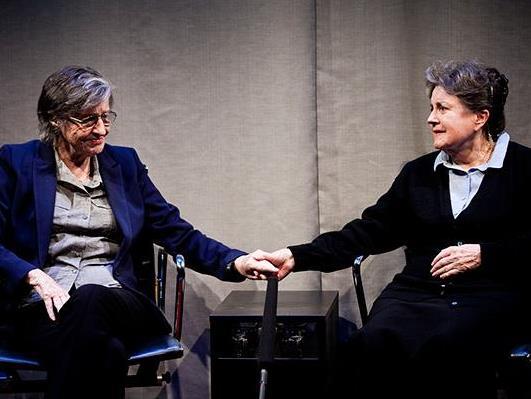Bates and Bayly in The Shoe-Horn Sonata, Ensemble Theatre; Photo Katy Green Loughrey
The Shoe-Horn Sonata returns two veterans of the Australian stage, Sandra Bates and Lorraine Bayly, to The Ensemble Theatre where they had played these very roles in 1997. The production also marks the “swansong” of both actors and, notably, Bates’s exit as Ensemble Artistic Director after 30-years.
John Miso’s 1995 play is not a surprising choice given we are in the verve of the Anzac centenary. It is an alluring tribute but has a further currency with its place on the HSC English syllabus for 2015-2020, reiterating its position as an Australian classic.
Bates and Bayly play an Australian nurse and a young British woman, respectively, who were thrown together in the flight from Singapore and then interned in the Japanese camps in WWII. It is a story of survival and friendship. However, when the war ended, so did their friendship for the next fifty years. It is a slow reveal, and one that describes a complex landscape of shame and post-traumatic stress.
While the rapport between the two holds the intensity of the play, Anna Gardiner’s set design unfortunately is unimaginative and awkwardly placed. The characters move between a hotel room, where a bed abuts the audience and is unnecessarily confrontational, to a loose suggestion of the TV studio represented as a couple of chairs and an “On Air” sign. The two women are the subject of a TV special devoted to the memories of Australian women POWs.
Peter Neufeld’s lighting was key in demarcating space, and a closing spotlight on “the shoe horn” symbolically frames the narrative. It was a gift to Bridie – Bates’ character – by her father as a young nurse heading off to the War. It was the metronome for the women’s choir in the camp, and the symbolic keeper of a memory that had torn the pair apart, and would eventually heal wounds.
While visually the staging hardly got one excited, the simplicity of the production did shift the focus onto the performances. Bayly and Bates are beautifully cast in these roles and their maturity adds authenticity to their delivery. The personality jar between “no-frills aussie” Bridie and “glove wearing, one-for-the-crown” Sheila adds an interlude of humour required to keep this play in balance.
That said, this is a text-heavy play and is theatrically challenging for its length and emotional intensity. Bailey’s performance was slightly stronger of the two; Bates at times struggled with the script’s delivery. However, these moments did not feel as bad as they may have in another play. The characters were aged; there was an emotional rawness and stumble of the topic, and a nervousness of speaking on television. Audiences were forgiving.
One of the gems of this play is its phrasing, and how sound was used to pick up where the more difficult memories were too hard to speak, offering a necessary pause. Projections using archive photographs helped visualise this “memory”, and while a good idea as punctuation, they lacked imagination again in their presentation.
The second act was a little more jumpy, the pace increased, but that was Misto’s writing, perhaps aimed at urgency, or a kind of “rain-away train” let go as the pair move towards a catharsis from shame. Both women had harboured secrets over the past fifty years. The old adage time heals is challenged by Misto, rather suggesting confrontation offers a better segue to peace.
It is a curious metaphor then, at the retirement of these veteran performers, The Shoe-Horn Sontata was the apt choice as walking away with a point of resolve. This play looks at history – and indeed celebrates a moment in our own contemporary history as loyal Sydney theatre audiences bid farewell to a remarkable pair.
The Shoe-Horn Sonata has been reprinted 15 times and sold 50,000 copies. The Ensemble season has been extended to The Concourse at Chatswood.
Rating: 3.5 out of 5
Ensemble Theatre
Sydney until 28 June
Season extended limited tickets
The Concourse in Chatswood
2 July
Ttickets available





